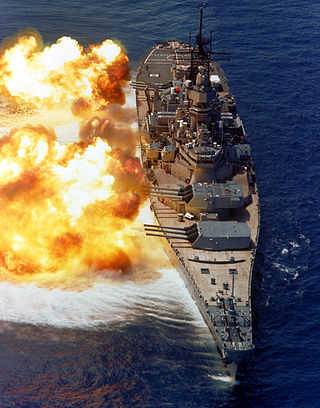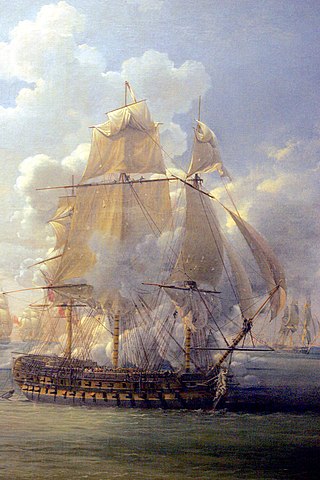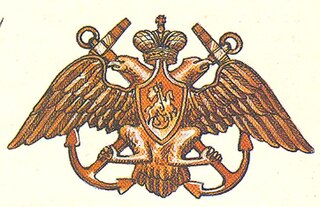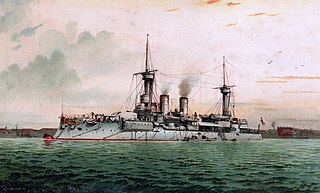Lists of ships include:

A battleship is a large armored warship with a main battery consisting of large caliber guns. It dominated naval warfare in the late 19th and early 20th centuries.

A cruiser is a type of warship. Modern cruisers are generally the largest ships in a fleet after aircraft carriers and amphibious assault ships, and can usually perform several roles.

A frigate is a type of warship. In different eras, the roles and capabilities of ships classified as frigates have varied somewhat.

A ship of the line was a type of naval warship constructed during the Age of Sail from the 17th century to the mid-19th century. The ship of the line was designed for the naval tactic known as the line of battle, which depended on the two columns of opposing warships maneuvering to volley fire with the cannons along their broadsides. In conflicts where opposing ships were both able to fire from their broadsides, the opponent with more cannons firing – and therefore more firepower – typically had an advantage. Since these engagements were almost invariably won by the heaviest ships carrying more of the most powerful guns, the natural progression was to build sailing vessels that were the largest and most powerful of their time.
This is an index of lists of shipwrecks, sorted by different criteria.

A warship or combatant ship is a naval ship that is built and primarily intended for naval warfare. Usually they belong to the armed forces of a state. As well as being armed, warships are designed to withstand damage and are typically faster and more maneuverable than merchant ships. Unlike a merchant ship, which carries cargo, a warship typically carries only weapons, ammunition and supplies for its crew. Warships usually belong to a navy, though they have also been operated by individuals, cooperatives and corporations.

The HX convoys were a series of North Atlantic convoys which ran during the Battle of the Atlantic in the Second World War. They were east-bound convoys and originated in Halifax, Nova Scotia from where they sailed to ports in the United Kingdom. They absorbed the BHX convoys from Bermuda en route. Later, after the United States entered the war, HX convoys began at New York.

The Regia Marina or Royal Italian Navy was the navy of the Kingdom of Italy from 1861 to 1946. In 1946, with the birth of the Italian Republic, the Regia Marina changed its name to Marina Militare.
The names of commissioned ships of the United States Navy all start with USS, for United States Ship. Non-commissioned, primarily civilian-crewed vessels of the U.S. Navy under the Military Sealift Command have names that begin with USNS, standing for United States Naval Ship. A letter-based hull classification symbol is used to designate a vessel's type. The names of ships are selected by the Secretary of the Navy. The names are those of states, cities, towns, important persons, important locations, famous battles, fish, and ideals. Usually, different types of ships have names originated from different types of sources.

Scuttling is the deliberate sinking of a ship. Scuttling may be performed to dispose of an abandoned, old, or captured vessel, to prevent the vessel from becoming a navigation hazard, as an act of self-destruction to prevent the ship from being captured by an enemy force, as a blockship to restrict navigation through a channel or within a harbor, to provide an artificial reef for divers and marine life, or to alter the flow of rivers.

The Imperial Russian Navy operated as the navy of the Russian Tsardom and later the Russian Empire from 1696 to 1917. Formally established in 1696, it lasted until dissolved in the wake of the February Revolution of 1917. It developed from a smaller force that had existed prior to Tsar Peter the Great's founding of the modern Russian navy during the Second Azov campaign in 1696. It expanded in the second half of the 18th century and reached its peak strength by the early part of the 19th century, behind only the British and French fleets in terms of size.

Georgios Averof is a modified Pisa-class armored cruiser built in Italy for the Royal Hellenic Navy in the first decade of the 20th century. The ship served as the Greek flagship during most of the first half of the century. Although popularly known as a battleship (θωρηκτό) in Greek, she is in fact an armored cruiser, the only ship of this type still in existence.

SMS Weissenburg was one of the first ocean-going battleships of the Imperial German Navy. She was the third pre-dreadnought of the Brandenburg class, which also included her sister ships Brandenburg, Wörth, and Kurfürst Friedrich Wilhelm. Weissenburg was laid down in 1890 in the AG Vulcan dockyard in Stettin, launched in 1891, and completed in 1894. The Brandenburg-class battleships were unique for their era in that they carried six large-caliber guns in three twin turrets, as opposed to four guns in two turrets, as was the standard in other navies.

Already in the 9th century, the Kievan Rus' had a powerful naval fleet which is proved by the successful naval Siege of Constantinople of 860. However, the naval fleet was irregular and was built only for the purpose of raids. Due to several major weakness of the naval fleet and in addition destructive invasion by the Mongol Empire, later the irregular naval fleet of the Kievan Rus principalities was dissolved. Except for the Principality of Novgorod which had access to the open seas and also was saved from Mongol invasions. In the 14th century, raids by Novgorod pirates, or ushkuiniki, sowed fear as far as Kazan and Astrakhan. As the first and proper Russian state of the Grand Duchy of Moscow begun and also got access to open water bodies, the Golden Age of the Russian Navy began. In 1570, in order to protect Russian navigation at the Baltic Sea, Ivan the Terrible created a flotilla which existed for about a year. In the 16th century, the Tsardom of Russia fought against the Ottoman Empire to get free access to the Black Sea.

Yadigar-i Millet, originally built as SMS S166, was one of the four S138-class torpedo boats built for the German Imperial Navy, but was purchased by the Ottoman Navy National Support Association for the Ottoman Navy.